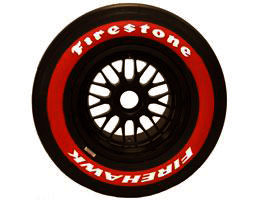Firestone Racing Introduces Alternate Tires To IndyCar SeriesProgram will be used at all street- and road-course events
NASHVILLE, Tenn. (March 26, 2009) — In order to increase on-track overtaking opportunities, making IndyCar Series street- and road-course races even more exciting for fans to watch, Firestone Racing is introducing the alternate tire concept to all seven of these events on the 2009 IndyCar Series schedule.
 The alternate tires, which are easily identifiable by their bright red sidewalls, are identical in body construction to the primary black-sidewalled Firestone Firehawk racing slicks. The alternates feature a softer tread compound that yields faster lap times, but as a result trade some compound durability from the primary specification for these faster times. That means two tire specifications (primary and alternate) have been developed for all seven road/street course races on the 2009 IndyCar Series schedule.
The alternate tires, which are easily identifiable by their bright red sidewalls, are identical in body construction to the primary black-sidewalled Firestone Firehawk racing slicks. The alternates feature a softer tread compound that yields faster lap times, but as a result trade some compound durability from the primary specification for these faster times. That means two tire specifications (primary and alternate) have been developed for all seven road/street course races on the 2009 IndyCar Series schedule.
“Bridgestone Americas Motorsports pioneered the alternate tire concept and introduced it to competition at the 2004 Toyota Grand Prix of Long Beach,” said Al Speyer, Executive Director, Firestone Racing. “Since that time, the idea has evolved and has been applied in other forms of motorsports. We are further tweaking the program for the IndyCar Series this season, and it will be entertaining to watch as it unfolds.
“It’s quite a task to develop, test and approve for use a second Firestone Firehawk tire compound for seven very different racetracks,” Speyer continued. “But we believe, and many agree, that the alternate tires will contribute another element of excitement to IndyCar Series racing.”
The alternate Firehawk tires, or “reds” as they’re commonly called, are available in limited quantities on a race weekend – only three sets per car, with each team required to use at least one unused, “sticker” set for at least two green-flag laps in the race. Thus, the alternate tire concept throws in a tantalizing element of strategy as each team determines when to utilize its “reds” and for how long in a race. The alternates will play a vital role in the IndyCar Series’ popular “knockout” qualifying system as well, as teams must decide whether to use a set of “Firehawk reds” in a particular segment.
In order to help the IndyCar Series cars go faster, a softer compound will provide more grip and will adhere to the track surface better. This should lead to later braking and faster cornering speeds. However, even utilizing the highest technology currently available,a soft compound is not going to be as durable against the high speeds, abrasive track surfaces and heat. Therefore, tire management is a crucial aspect of the alternate tire program.
Bridgestone Americas Tire Operations (BATO) utilizes the racing arena as the ultimate public laboratory, testing and perfecting newer and better technologies that improve every aspect of a race tire’s performance. Through the years, many innovations developed at the track have made their way into the fine line of Bridgestone- and Firestone-branded passenger vehicle tires. Ultimately, BATO hopes to utilize technology discovered through this program to narrow the inherent trade-off that occurs between the grip a tire offers and its overall durability. This is something everyone would value in their street car tires – more grip without compromising the life of the tire.
Firestone Racing is acting on the request of the IndyCar Series in developing and implementing the alternate tire program for 2009. It takes a very technologically advanced company to produce an alternate tire to meet the IndyCar Series’ exacting specifications. So when an alternate tire loses a bit of performance, remember that it is doing exactly what it was intended to do. Introducing the alternate tire concept to the IndyCar Series is the latest example of Firestone Racing’s ongoing effort to bring fans the most electrifying racing available anywhere.
About Bridgestone Americas Tire Operations:
Nashville, Tenn.-based Bridgestone Americas Tire Operations (BATO) is a business unit of Bridgestone Americas, Inc., whose parent company, Bridgestone Corporation, is the world's largest tire and rubber company. Reporting into the BATO business unit are the company's Latin American tire operations, the U.S. and Canadian consumer tire businesses and the U.S. and Canadian commercial tire businesses. BATO develops, manufactures and markets Bridgestone, Firestone and associate brand tires. The business unit is focused on retail, wholesale and original equipment markets, supplying passenger, light truck, commercial vehicle, off road, motorcycle, agricultural and other tires to its customers in the Americas. In addition, through its Bridgestone Bandag Tire Solutions unit, retreading customers have access to industry-leading research and development, manufacturing, marketing and sales expertise, providing them with a total tire solution.

